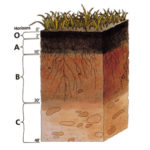Vertical mulching

One of the biggest hurdles for planting in the urban environment is soil compaction. Heavy equipment used during the building process, or for mowing and landscaping, can cause the soil to become so compacted as to not allow roots to spread, not allow water to be absorbed or drain away, deprive the plant of oxygen in the root zone, and subsequently not allow nutrient absorption. Even foot traffic causes significant compaction. Some of the largest trees in the world have been killed by the foot traffic of people coming to see the tree, and steps have to be taken to protect them. When your dog runs the same path over and over the grass doesn’t grow due to compaction, and even animals as small as squirrels and chipmunks can make tiny trails where plants don’t grow.

The effects of soil compaction
One of the best methods of addressing soil compaction is a process called vertical mulching. It’s a form of aerating similar to the plugs pulled out by lawn aerating, just on a bigger scale. It’s done by drilling holes, ideally with a two inch diameter auger (something heavy duty) in a grid pattern with the holes 2 feet apart and up to two feet deep. Obviously call Miss Dig to locate utilities (248-370-6400 or 800-482-7171), and be prepared to do some irrigation repairs if necessary.
This is how it helps. Immediately it allows oxygen, water, and added nutrients access to the plants root zone. This is just the beginning of a long lasting process. In the winter, water freezes in the holes and expands causing the soil to fracture. These fractures in turn fill with water, freeze, expand, and cause further fracturing. The more this happens, the more oxygen and water are available in the root zone. The longer the holes can be kept open, the longer the process will go on. They can be kept open by adding aggregate or using soil aeration tubes (see photo). The tubes may not be cost effective for large areas, but they are better than aggregate as they leave the hole completely open to allow more water and air to reach the root zone. Also, they are capped against debris filling them up and can be uncapped to add nutrients. Eventually roots will render them useless, but by then they will have done their job.

As far as drilling the holes, you can do it manually using the biggest electric drill you can find. I rented one once that had two handles like a jackhammer with the trigger in one of the handles. A posthole digger on a tractor or other piece of equipment would work well for large areas.
For lawn aeration, pulling plugs is an excellent option for lawn health (note: this should be done when the ground is moist so the plug can be cleanly removed), but for landscape beds vertical mulching is the best method to properly aerate, and if done manually can be done in established beds. Using this method you can overcome the hurdle of soil compaction and your plants will thank you for it by growing big and beautiful.

